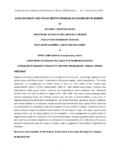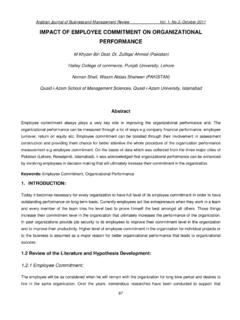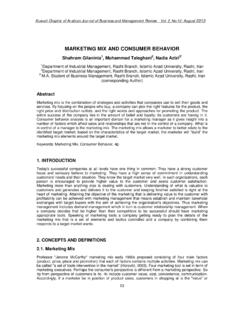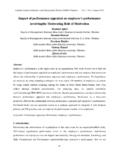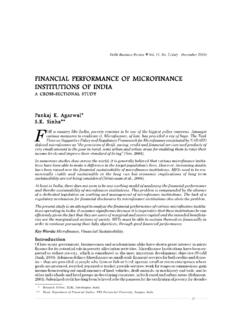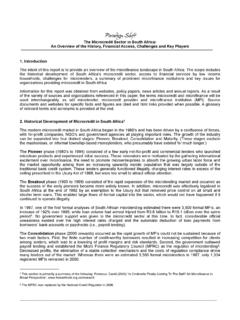Transcription of AN ANALYSIS OF MICROFINANCE AND POVERTY …
1 Kuwait Chapter of Arabian Journal of Business and Management Review Vol. 1, ; March 2012. AN ANALYSIS OF MICROFINANCE AND POVERTY reduction IN BAYELSA STATE OF NIGERIA. APPAH, EBIMOBOWEI. DEPARTMENT OF ACCOUNTING, FACULTY OF BUSINESS EDUCATION. JOHN, M. SOPHIA. DEPARTMENT OF ECONOMICS, FACULTY OF SOCIAL SCIENCES. SOREH WISDOM. DEPARTMENT OF ACCOUNTING, FACULTY OF BUSINESS EDUCATION. BAYELSA STATE COLLEGE OF EDUCATION, OKPOAMA, BRASS-ISLAND, YENAGOA, NIGERIA. ABTRACT. This study investigates the relationship between MICROFINANCE and POVERTY reduction in Bayelsa State of Nigeria. Relevant literatures were reviewed for the study.
2 To guide the study, four hypotheses were developed. They were used to measure the main variables of the study. The target population for this study was all women involved in small scale business in Bayelsa State, Nigeria. A sample of 286 respondents was purposively selected for the study. The instrument for the study was a questionnaire titled MICROFINANCE and POVERTY reduction . To analyse the data generated, the chi-sqaure, ANOVA and descriptive statistics were used. The ANALYSIS of the data revealed that there is a significant relationship between MICROFINANCE and POVERTY reduction in Bayelsa State; there is a significant difference between MICROFINANCE and traditional rotating system; there is significant difference between loan repayment by the women and POVERTY reduction in Bayelsa State and significant difference between MICROFINANCE and the status of women in Bayelsa State, Nigeria.
3 The conclusion drawn from this study therefore was that MICROFINANCE alone cannot reduce POVERTY in any society where basic infrastructures like good roads, steady power supply, good transportation system etc are nearly not available for the women to benefits from the introduction of MICROFINANCE in Nigeria. The study therefore recommends among others that the governments in developing economies like Nigeria should as a matter of national priority provide the basic infrastructural facilities to enable small business owners grow; the National POVERTY Alleviation Programme (NAPEP) should be well strengthened to reduce the level of political manipulation by political leaders in the country.
4 Anda reduction in the interest rate for MICROFINANCE institutions and other stringent issues about MICROFINANCE model of POVERTY reduction should be adequately and seriously applied to minimize the level of POVERTY in Nigeria. Keywords: MICROFINANCE , POVERTY reduction , Bayelsa State, Nigeria. 38. Kuwait Chapter of Arabian Journal of Business and Management Review Vol. 1, ; March 2012. 1. INTRODUCTION. POVERTY reduction has been an important development challenge over decades. One of the identified constraints facing the poor is lack of access to formal sector funds to enable them to take advantage of economic opportunities to increase their level of output, hence move out of POVERTY .
5 The wide-spread POVERTY , with all the problems that comes with it, is the greatest challenge of our time. Traditional aid has not helped in solving this problem. One kind of development work, which promotes financial sustainability for poor individuals in the society, is micro finance (Lindvert, 2006). The MICROFINANCE revolution has changed attitudes towards helping the poor in many countries and in some has provided substantial flow of finance, often to very low-income groups or households, who would normally be excluded by conventional financial institutions (Kurmanalieva, Montgomery and Weiss, 2003). According to Morduch and Haley (2001), MICROFINANCE has proven to be an effective and powerful tool for POVERTY reduction .
6 Like many other development tools, however, it has insufficiently penetrated the poorer strata of the society. The poorest form the vast majority of those without access to primary health care and basic education; similarly, they are the majority of those without access to MICROFINANCE . Also, Hussien and Hussain (2003) say there is increasing reliance on MICROFINANCE as an instrument of POVERTY alleviation in Pakistan. The unwillingness or inability of the formal financial institutions to provide financial services to the urban and rural poor, coupled with the unsustainability of government sponsored development financial schemes contributed to the growth of private sector led MICROFINANCE in Nigeria (Anyanwu, 2004).
7 Shastri (2009) maintain that the credit policy for the poor involves many practical difficulties arising from operation followed by financial institutions and the economic characteristics and financing needs of low-income households. For example, commercial banking institutions require that borrowers have a stable source of income out of which principal and interest can be paid back according to the agreed terms. However, the income of many self employed households is not stable. A huge number of micro loans are needed to serve the poor, but banking institution prefers dealing with big loans in small numbers to minimize administration expenses.
8 They also 39. Kuwait Chapter of Arabian Journal of Business and Management Review Vol. 1, ; March 2012. look for collateral with a clear title-which many low income households do not have . Momoh (2005) said with an effective and efficient MICROFINANCE system operating in rural areas of developing countries, coupled with other enabling factors such as legal and policy framework, good governance and adequate physical infrastructure, the poor rural people will undertake diversified business activities, and also be able to adopt more appropriate modern farming technologies. This, it is assumed, will lead to the reduction of rural POVERTY and an increased overall standard of living of the rural poor in developing countries in general, and the Least Developed Countries (LDCs) like those in Sub-Saharan Africa and South Asia, in particular.
9 Latifee (2003) also argues that the poor live in a high risk and vulnerable conditions. Their ability to take advantage of opportunities that will lead to increasing their income or economic status, to protect themselves against risks of crises, and to cope with these when they occur is very significant. reduction of POVERTY is partly a process of increasing income and economic stability which enables fulfillment of basic needs and access to different kinds of services. This may also be understood in the form of developing a range of assets that will reduce the vulnerability of the poor of physical, economic and social shocks.
10 Therefore, several studies have been published on MICROFINANCE and POVERTY reduction . In some of these studies, MICROFINANCE has brought positive impact to the life of clients, boost the ability of poor individuals to improve their conditions and others have indicated that poor people have taken advantage of increased earnings to improve their consumption level, health and build assets. However, other studies have shown that MICROFINANCE is said to play insignificant role towards POVERTY reduction . These various arguments on the role of MICROFINANCE in reducing POVERTY in different parts of the world necessitated the researchers to ask the following questions in Bayelsa State: can MICROFINANCE be an effective strategy for POVERTY reduction ?
